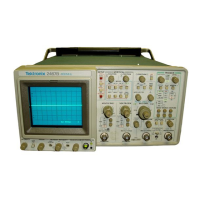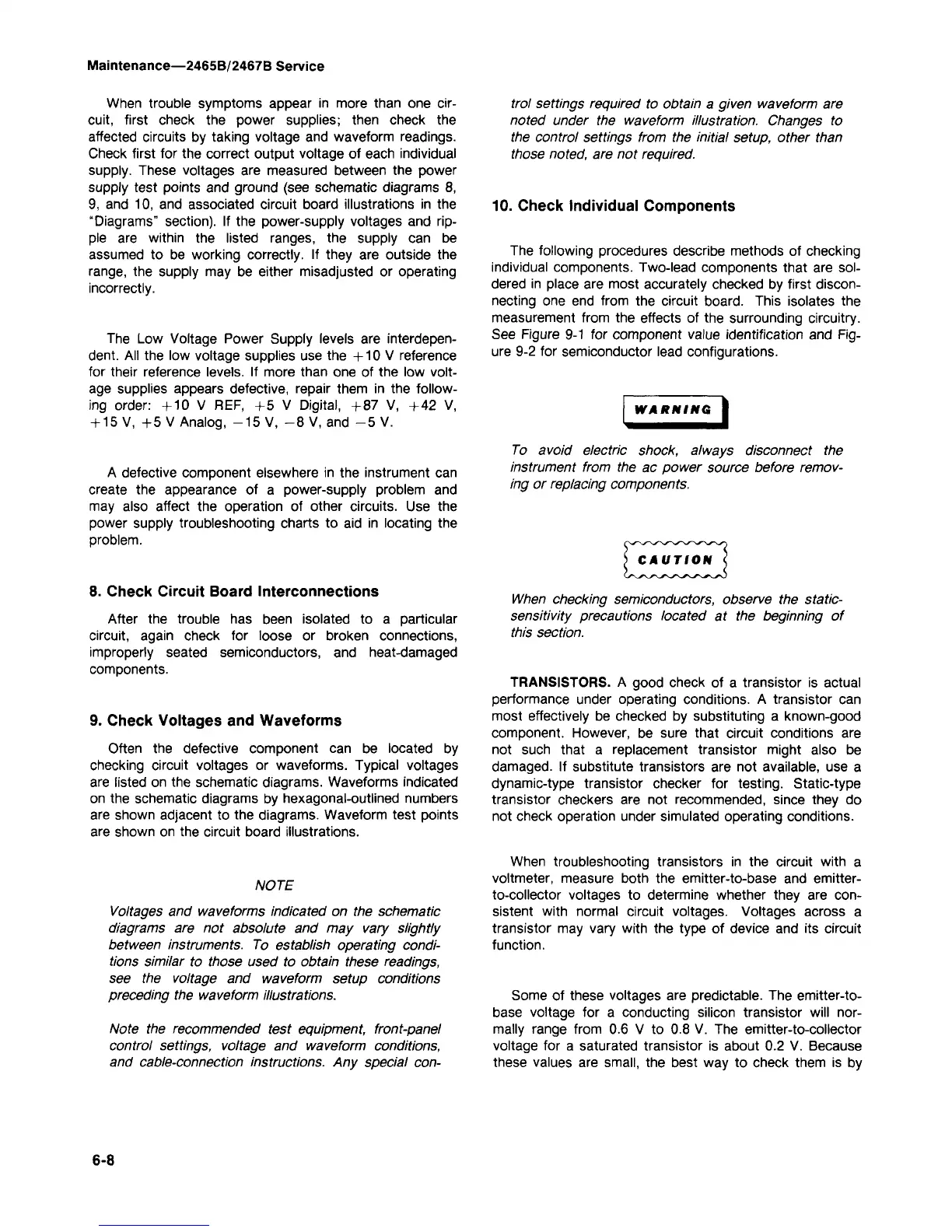Maintenance—2465B/2467B Service
When trouble symptoms appear in more than one cir-
cuit, first check the power supplies; then check the
affected circuits by taking voltage and waveform readings.
Check first for the correct output voltage of each individual
supply. These voltages are measured between the power
supply test points and ground (see schematic diagrams 8,
9, and 10, and associated circuit board illustrations in the
"Diagrams" section). If the power-supply voltages and
rip-
ple are within the listed ranges, the supply can be
assumed to be working correctly. If they are outside the
range,
the supply may be either misadjusted or operating
incorrectly.
The Low Voltage Power Supply levels are interdepen-
dent. All the low voltage supplies use the +10 V reference
for their reference levels. If more than one of the low volt-
age supplies appears defective, repair them in the follow-
ing order: +10 V REF, +5 V Digital, +87 V, +42 V,
+ 15 V, +5 V Analog, -15 V, -8 V, and -5 V.
A defective component elsewhere in the instrument can
create the appearance of a power-supply problem and
may also affect the operation of other circuits. Use the
power supply troubleshooting charts to aid in locating the
problem.
8. Check Circuit Board Interconnections
After the trouble has been isolated to a particular
circuit, again check for loose or broken connections,
improperly seated semiconductors, and heat-damaged
components.
9.
Check Voltages and Waveforms
Often the defective component can be located by
checking circuit voltages or waveforms. Typical voltages
are listed on the schematic diagrams. Waveforms indicated
on the schematic diagrams by hexagonal-outlined numbers
are shown adjacent to the diagrams. Waveform test points
are shown on the circuit board illustrations.
NOTE
Voltages and waveforms indicated on the schematic
diagrams are not absolute and may vary slightly
between instruments. To establish operating condi-
tions similar to those used to obtain these readings,
see the voltage and waveform setup conditions
preceding the waveform illustrations.
Note the recommended test equipment, front-panel
control settings, voltage and waveform conditions,
and cable-connection instructions. Any special con-
trol settings required to obtain a given waveform are
noted under the waveform illustration. Changes to
the control settings from the initial setup, other than
those noted, are not required.
10.
Check Individual Components
The following procedures describe methods of checking
individual components. Two-lead components that are
sol-
dered in place are most accurately checked by first discon-
necting one end from the circuit board. This isolates the
measurement from the effects of the surrounding circuitry.
See Figure 9-1 for component value identification and
Fig-
ure 9-2 for semiconductor lead configurations.
WARNING
To avoid electric shock, always disconnect the
instrument from the ac power source before remov-
ing or replacing components.
When checking semiconductors, observe the static-
sensitivity precautions located at the beginning of
this section.
TRANSISTORS. A good check of a transistor is actual
performance under operating conditions. A transistor can
most effectively be checked by substituting a known-good
component. However, be sure that circuit conditions are
not such that a replacement transistor might also be
damaged.
If substitute transistors are not available, use a
dynamic-type transistor checker for testing. Static-type
transistor checkers are not recommended, since they do
not check operation under simulated operating conditions.
When troubleshooting transistors in the circuit with a
voltmeter, measure both the emitter-to-base and emitter-
to-collector voltages to determine whether they are
con-
sistent with normal circuit voltages. Voltages across a
transistor may vary with the type of device and its circuit
function.
Some of these voltages are predictable. The emitter-to-
base voltage for a conducting silicon transistor will nor-
mally range from 0.6 V to 0.8 V. The emitter-to-collector
voltage for a saturated transistor is about 0.2 V. Because
these values are small, the best way to check them is by
6-8

